In the age of digital commerce, selling antiques has evolved from traditional brick-and-mortar establishments to a vast array of online marketplaces catering to diverse audiences and preferences. From well-known platforms like eBay and Etsy to specialized marketplaces like Ruby Lane and 1stdibs, sellers now have a plethora of options to showcase their unique treasures to a global audience.
In this era of interconnectedness, understanding the landscape of online antique marketplaces is crucial for sellers seeking to maximize exposure, connect with the right buyers, and ultimately achieve success in the competitive world of antique commerce.
This overview will delve into the top online marketplaces for selling antiques, exploring their features, pros and cons, and target audiences to help sellers navigate the diverse landscape and make informed decisions about where to list their prized possessions.
Each of these platforms offers unique features and caters to different types of sellers and buyers, so it’s essential to consider your specific needs and target audience when choosing where to sell your antiques.
1. eBay
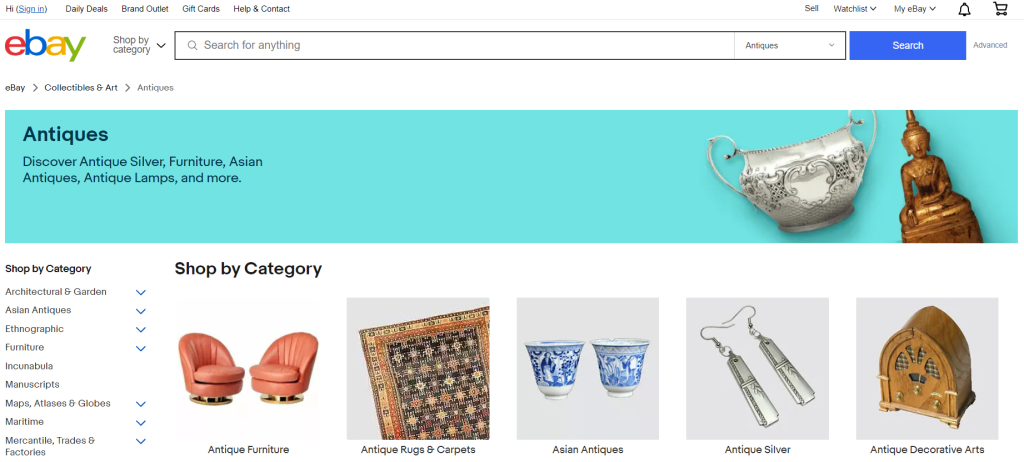
eBay is a widely used online marketplace where users can buy and sell various items, including antiques, through auctions or fixed-price listings.
Pros:
- Large user base, offering extensive reach to potential buyers.
- Flexible listing options with auctions or fixed-price listings.
- International shipping options expand the potential market for sellers.
Cons:
- Fees for listing items and final sale value.
- Competition from other sellers can affect visibility.
- Limited control over buyer communication and disputes.
Target Audience:
Sellers looking for a broad audience and flexible selling options, particularly those interested in international sales.
2. Etsy
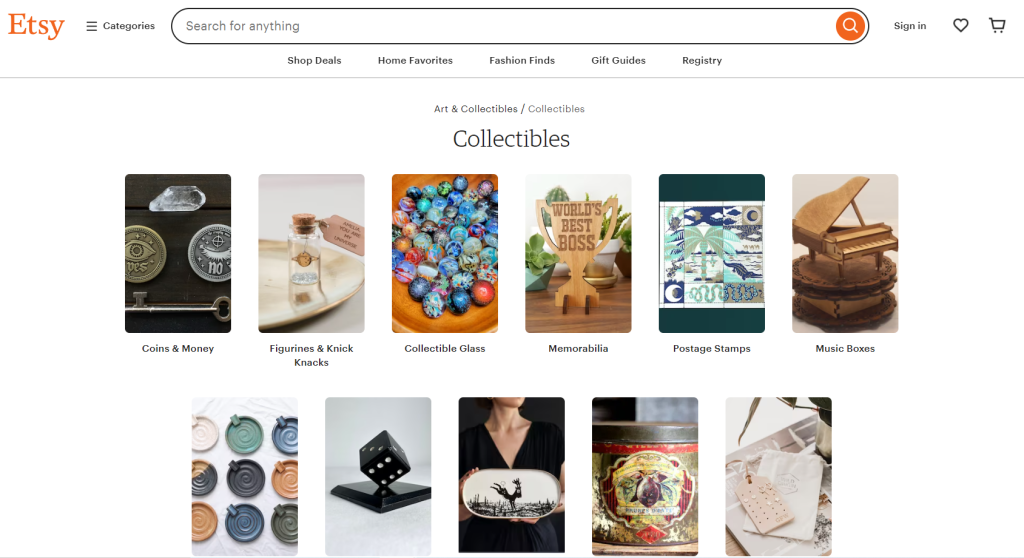
Etsy is an online marketplace specializing in handmade, vintage, and unique goods, including antiques, crafts, and art.
Pros:
- Niche marketplace focusing on handmade and vintage items.
- Supportive community and resources for sellers.
- Customizable storefronts and branding options.
Cons:
- Listing fees and transaction fees apply.
- Competition from other sellers within the niche.
- Limited to handmade, vintage, and craft items, may not be suitable for all antiques.
Target Audience:
Artisans, crafters, and vintage sellers seeking a niche marketplace with a community-oriented approach.
Register here and get 40 free listings.
3. Ruby Lane

Ruby Lane is an online marketplace specializing in antiques, art, vintage collectibles, and jewelry, offering a curated platform for buyers and sellers.
Pros:
- Curated marketplace focusing on quality antiques and collectibles.
- Higher-end clientele seeking unique and rare items.
- Personalized customer service and support for sellers.
Cons:
- Monthly maintenance fees for shop owners.
- Strict acceptance criteria for listings.
- Smaller audience compared to larger marketplaces.
Target Audience:
Sellers of high-quality antiques and collectibles seeking a curated platform with personalized support.
4. 1stdibs
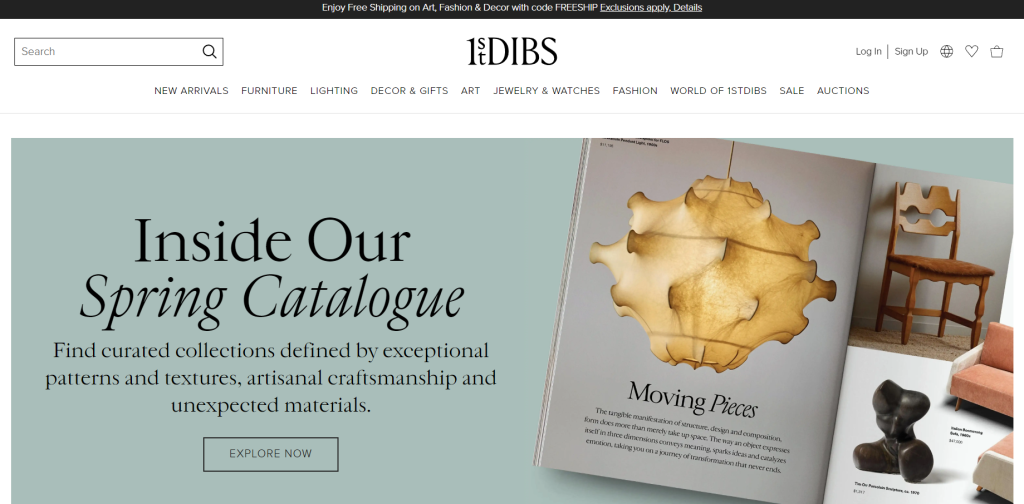
1stdibs is a high-end online marketplace specializing in luxury items, including fine art, antiques, furniture, and jewelry, catering to affluent buyers and collectors.
Pros:
- Prestigious platform catering to luxury items and high-end clientele.
- Global reach with a network of international dealers and collectors.
- Enhanced features for sellers, including professional photography and marketing.
Cons:
- High commission fees for sellers.
- Strict acceptance criteria for listings.
- Competition from other high-end dealers and galleries.
Target Audience:
Sellers of luxury and high-end antiques seeking a prestigious platform with a global reach.
If you need UPC/EAN codes to display your listings on any international platforms, you can learn more about it here:
5. Bonanza
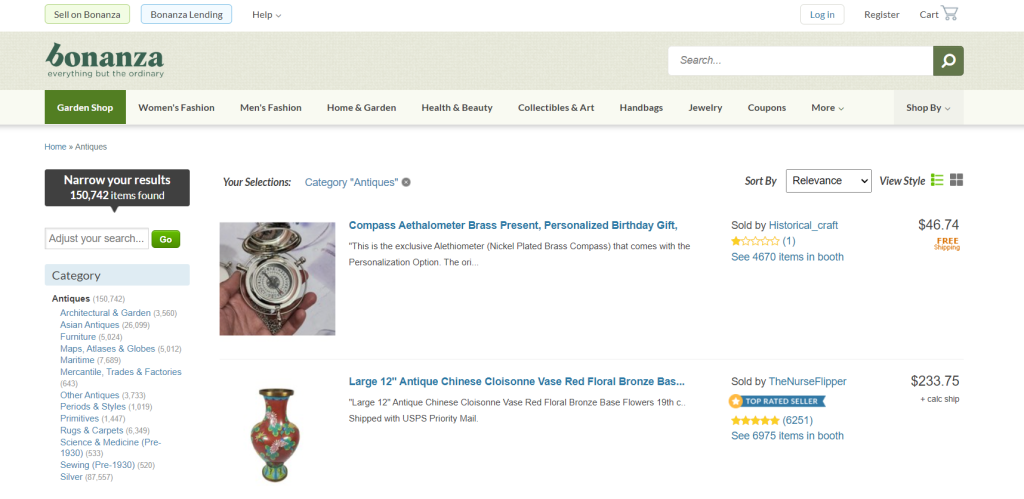
Bonanza is an online marketplace offering a wide range of products, including antiques, collectibles, and crafts, with a focus on providing a user-friendly experience for buyers and sellers.
Pros:
- Simple and user-friendly interface for listing items.
- Low fees compared to other marketplaces.
- Integration with other platforms like eBay and Shopify for streamlined selling.
Cons:
- Smaller user base compared to larger marketplaces.
- Less specialized for antiques compared to niche platforms.
- Limited marketing and advertising features.
Target Audience:
Sellers seeking a straightforward and cost-effective platform with integration options for cross-platform selling.
6. GoAntiques
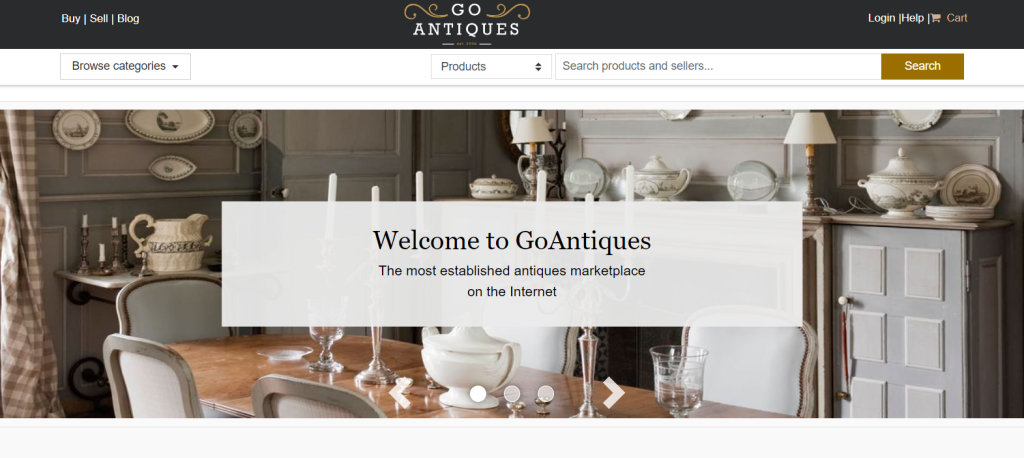
GoAntiques is an online marketplace specializing in antiques, collectibles, and vintage items, providing a platform for dealers and collectors.
Pros:
- Dedicated platform focusing on antiques and collectibles.
- Established user base of collectors and enthusiasts.
- Option for auctions or fixed-price listings.
Cons:
- Listing fees and commission fees apply.
- Competition from other dealers and sellers within the niche.
- Limited marketing and advertising features.
Target Audience:
Dealers and collectors specializing in antiques and vintage items seeking a dedicated marketplace.
7. Facebook Marketplace
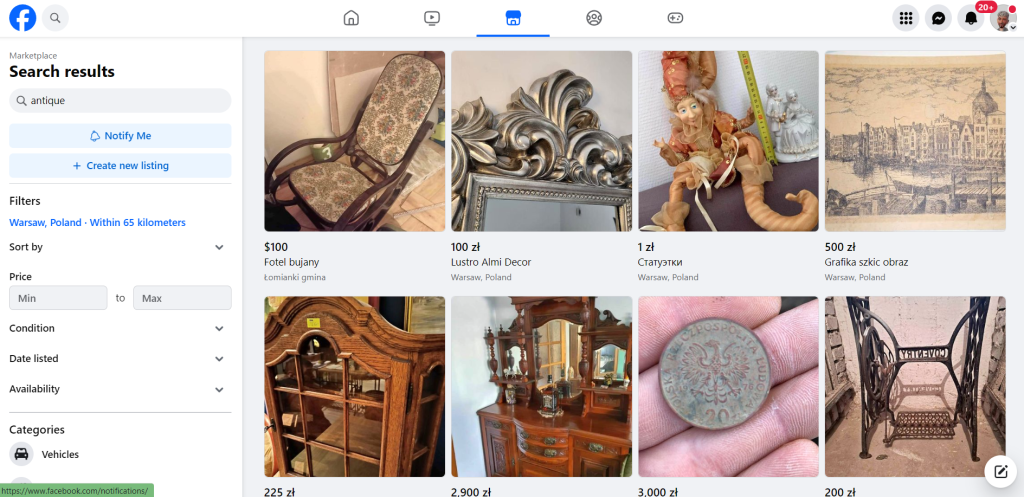
Facebook Marketplace is a platform integrated into Facebook where users can buy and sell various items, including antiques, within their local community.
Pros:
- Large user base with potential reach to local buyers.
- Free to use with no listing fees.
- Direct communication between buyers and sellers.
Cons:
- Limited to local transactions.
- Less specialized for antiques compared to niche platforms.
- Potential for scams or fraudulent listings.
Target Audience:
Local buyers and sellers seeking a convenient and free platform for transactions within their community.
8. Invaluable
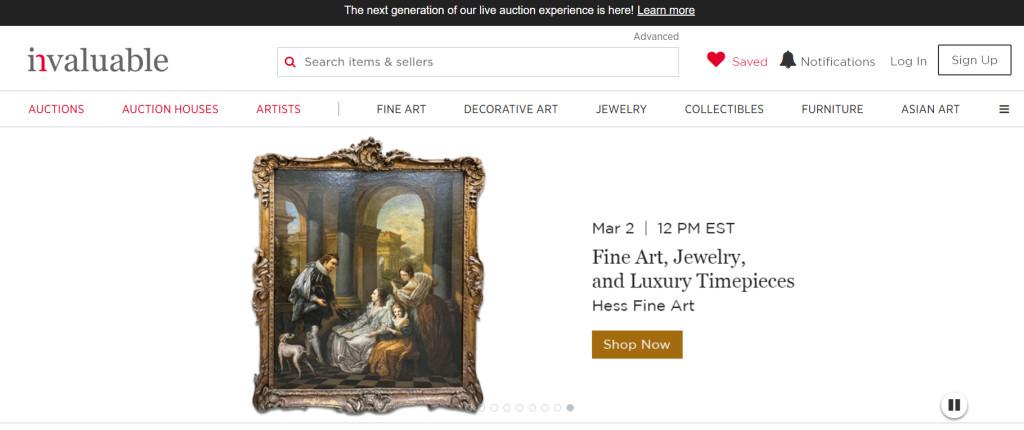
Invaluable is an online auction marketplace specializing in fine art, antiques, and collectibles, offering a platform for auction houses and dealers.
Pros:
- Specialized platform focusing on high-end antiques and collectibles.
- Option for live or timed online auctions.
- Global reach with a network of auction houses and dealers.
Cons:
- Listing and commission fees apply.
- Competition from other auction houses and dealers.
- Limited to high-end items, may not be suitable for all antiques.
Target Audience:
Auction houses, dealers, and collectors specializing in high-end antiques seeking a global platform for auctions.
9. LiveAuctioneers
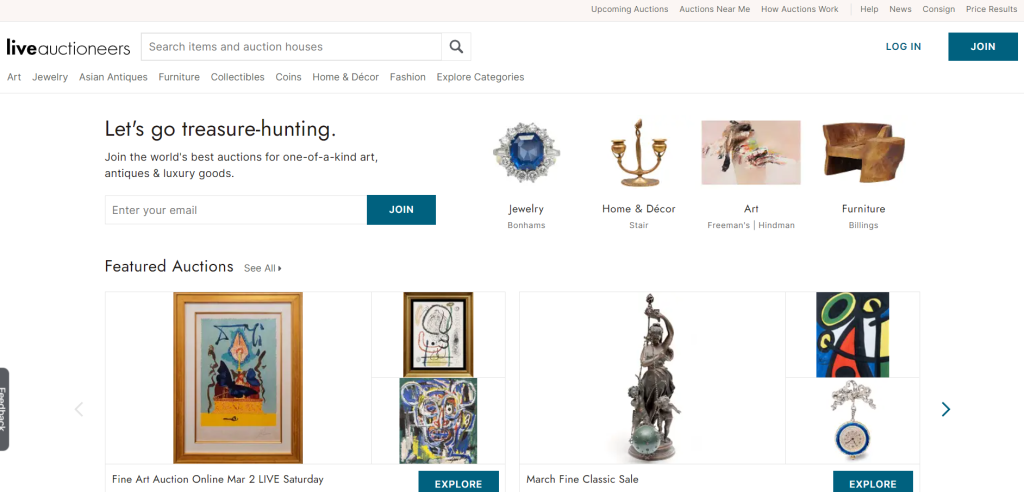
LiveAuctioneers is an online auction platform specializing in live and timed online auctions for antiques, art, and collectibles, connecting auction houses and buyers worldwide.
Pros:
- Platform for live and timed online auctions with real-time bidding.
- Global reach with a network of auction houses and buyers.
- Enhanced features for sellers, including cataloging and marketing services.
Cons:
- Listing and commission fees apply.
- Competition from other auction houses and sellers.
- Limited control over buyer communication and disputes.
Target Audience:
Auction houses, dealers, and collectors seeking a platform for live and timed online auctions with a global audience.
Important: You will need a VPN to view some resources. A reliable VPN with a dedicated IP is here!
10. Webstore
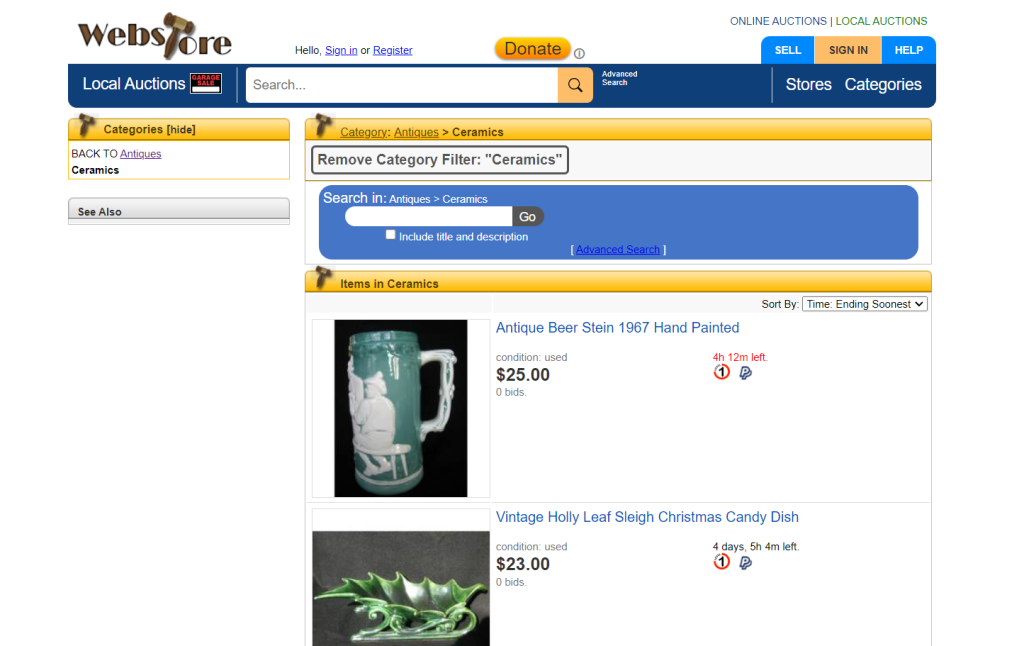
Webstore is an online marketplace where users can buy and sell a variety of items, including antiques, through fixed-price listings or auctions.
Pros:
- Free to list items.
- No transaction fees.
- Option for fixed-price or auction-style listings.
Cons:
- Smaller user base compared to larger marketplaces like eBay.
- Limited in terms of marketing and advertising features.
- May have less specialized audience for antiques.
Target Audience:
Sellers looking for a simple and cost-effective platform to list antiques without incurring transaction fees.
11. Chairish
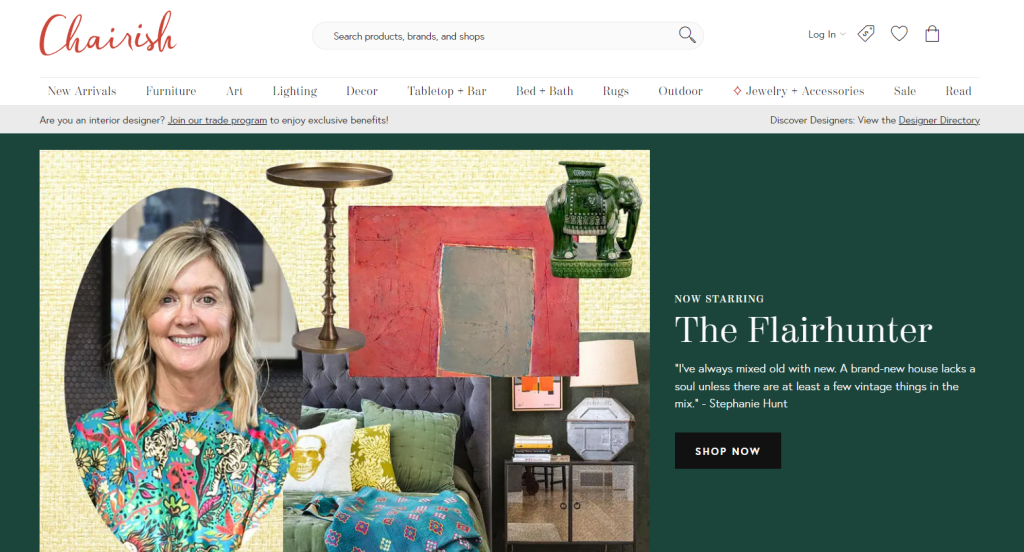
Chairish is an online marketplace specializing in high-quality pre-owned furniture, decor, and art, including antiques and vintage items.
Pros:
- Curated platform focusing on high-end antiques and decor.
- Option for white-glove delivery services.
- Enhanced features for sellers, including professional photography and styling.
Cons:
- High commission fees for sellers.
- Limited to high-end or designer items, may not be suitable for all antiques.
- Strict acceptance criteria for listings.
Target Audience:
Sellers of high-end or designer antiques and vintage items, as well as buyers seeking curated, quality pieces.
12. Craigslist
Craigslist is a classified advertisements website where users can post listings for various goods and services, including antiques, within their local area.
Pros:
- Free to use.
- Widely known and used in many localities.
- Direct communication between buyer and seller.
Cons:
- Limited moderation, leading to potential scams or spam.
- Transactions typically occur in person, which may pose safety concerns.
- Less specialized for antiques compared to other platforms.
Target Audience:
Local buyers and sellers looking for a wide range of goods, including antiques, within their immediate vicinity.
13. OfferUp
OfferUp is a mobile-focused marketplace where US users can buy and sell various items locally, including antiques, through in-app listings.
Pros:
- User-friendly mobile app interface.
- Large user base, especially in urban areas.
- Direct communication between buyers and sellers.
Cons:
- Limited to local transactions, may not be suitable for rare or specialized antiques.
- Potential for lowball offers and negotiation challenges.
- Limited in terms of specialized features for antique sellers.
Target Audience:
Local buyers and sellers seeking a convenient mobile platform for transactions, especially in urban areas.
14. LetGo
LetGo is a mobile marketplace where users can buy and sell various items locally, including antiques, through in-app listings.
Pros:
- User-friendly mobile app interface with photo recognition technology for listing items.
- Large user base, especially in urban areas.
- Direct communication between buyers and sellers.
Cons:
- Limited to local transactions.
- Less specialized for antiques compared to other platforms.
- Less stringent moderation may lead to lower quality listings.
Target Audience:
Local buyers and sellers seeking a convenient mobile platform for transactions, particularly in urban areas.
Conclusion
When it comes to selling antiques, there is a diverse range of online marketplaces available, each with its own set of features, benefits, and target audiences.
Here’s a summarized comparison:
General Marketplaces: Platforms like eBay, Bonanza, and Facebook Marketplace offer broad reach and flexibility but may lack specialization in antiques, potentially leading to increased competition and lower visibility for antique listings.
Niche Marketplaces: Platforms like Etsy, Ruby Lane, and Chairish cater specifically to handmade, vintage, or high-end antiques, providing a curated environment and often attracting buyers with a specific interest in unique or luxury items.
Auction Platforms: Platforms like Invaluable and LiveAuctioneers focus on online auctions, providing a platform for auction houses, dealers, and collectors to showcase high-end antiques and facilitate bidding from a global audience.
Local Marketplaces: Platforms like Craigslist, OfferUp, and LetGo facilitate local transactions, offering convenience for buyers and sellers looking to connect within their immediate vicinity, though they may lack specialized features for antique selling and pose potential safety concerns.
Ultimately, the best platform for selling antiques depends on factors such as:
- the nature of the items being sold,
- target audience preferences,
- desired level of specialization, and
- comfort level with various selling mechanisms (e.g., auctions, fixed-price listings).
You should carefully evaluate each platform’s features, fees, and audience reach to determine the most suitable option for your specific needs and goals.
Happy selling!


